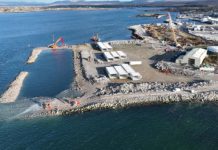The first acoustic devices to monitor marine mammals and underwater noise levels in European waters were deployed by researchers from ATU Galway recently.
ATU’s Dr María Pérez Tadeo and Erasmus intern Yaiza Pozo Galván deployed the monitoring devices in Turkey in recent days.
This is part of the EU-funded “Strategic Infrastructure for Improved Animal Tracking in European Seas” (STRAITS) project.
The research project will study the movement of sea animals at four strategic locations in Europe in a bid to better understand their biology and ecology, and aid in conservation and management.
Led by the Loughs Agency in Northern Ireland, the four-year €3.5m project is funded by the Horizon Europe Framework Program.
The project team is drawn from ten world-leading organisations that together will advance the public’s understanding of aquatic animal movements in Europe and abroad.

ATU’s focus will be specifically on the movement of marine mammals led by marine scientist Dr Joanne O’Brien, Principal Investigator, and Dr María Pérez Tadeo, postdoctoral researcher at the Marine and Freshwater Research Centre (MFRC) in ATU Galway.
Dr Tadeo, accompanied by Yaiza Pozo Galván, travelled to the Strait of Dardanelles last week to set up the equipment and co-ordinate the deployment of the first passive acoustic monitoring devices for the STRAITS project.
The research visit to Turkey was funded by the Oranmore-based Marine Institute.
Dr Tadeo explained that they brought the equipment to Turkey to set it up, and a research group from Ege University dived to attach it to their moorings in the Straits of Bosphorus and Dardanelles.
“There was a heavy storm over here not long after the dive so we were extremely lucky getting the equipment in the water beforehand, since the weather window was very brief.”

“Equipment was also shipped to Spain and was deployed last Wednesday in the Strait of Gibraltar by Dr Ricardo F Sánchez Leal and his team, researchers from the Spanish Oceanographic Institute.”
he study of animal movements offers one of the best ways to monitor animals from regional to continental or even global scales, and from minutes to decades.
Although animal tracking is not new, it is only recently that the technology has enabled the tracking of animals over larger areas and longer timescales.
This advancement has yielded key information about the biology and ecology of these animals, but much more knowledge could be gained if efforts to tag and detect animals were performed collaboratively, as part of a network.
Researchers at ATU are in charge of assessing underwater noise levels and monitoring marine mammals at the different sites, which will be of great relevance to assess impacts of anthropogenic noise on cetaceans and to comply with EU regulations.
Cetaceans, reliant on sound for communication, navigation and foraging, face risks from increasing anthropogenic activities, potentially causing physical damage and behavioural changes.
The STRAITS pan-European project sees acoustic telemetry arrays deployed in four major swimways in Europe:
- the Danish Straits, between the Kattegat Sea and the Baltic Sea
- the North Channel in the Celtic Sea
- the Strait of Gibraltar, between the Atlantic Ocean and the Mediterranean Sea
- the Strait of Bosphorus and Dardanelles, between the Mediterranean Sea and the Black Sea












